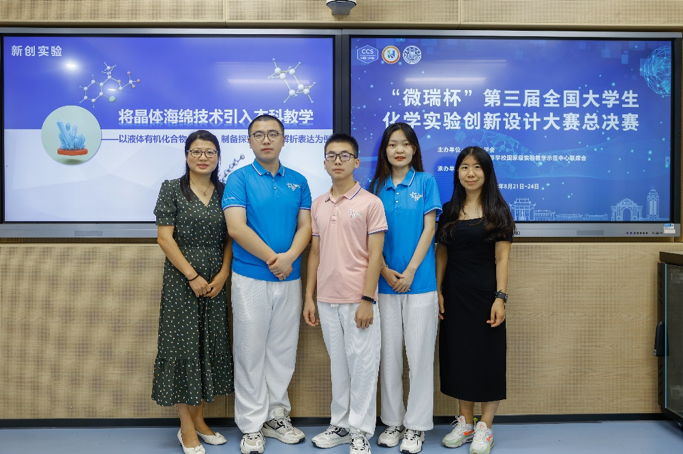A team consisting of three undergraduates from the University of Science and Technology of China (USTC), WANG Xiaoyu, ZOU Junxi and LIU Xuan, won the Grand Prize in the National Final of the 3rd National Student Chemical Experiment Innovation and Design Competition.
The team's work is "Introducing Crystal Sponge Technology into Undergraduate Teaching - An Investigation into the Preparation and Structural Analysis of Liquid Organic Compounds 'Single Crystals' as an Example." The work introduces a new "single crystal" growth and analysis technique developed in recent years, the crystal sponge technique, into undergraduate experimental teaching in a timely manner. By systematically optimizing the experimental conditions in their literature, setting up hierarchical experimental content and open research questions, the team carried out teaching practices, including the exploration of the preparation of crystal sponges, solvent exchange and evaluation, as well as the determination and visual representation of the single crystal structure of representative liquid organic compounds. This work was supervised by Ms. LI Lingling and Ms. ZHENG Yuan.

(Image by USTC: Group Photo of Team Members and Supervisors.)
The national final of the 3rd National Student Chemical Experiment Innovation Design Competition was jointly organized by the Chinese Chemical Society and the National Demonstration Center for Experimental Education. This competition was first held in the North, East, South, Northeast, Northwest, Southwest and Central China, with about 908 teams from 410 universities.In accordance with the three tracks of new experimental design, improvement of existing experiments, and popular science experimental design, the competition was held in all sub-regions, and finally 90 teams representing 90 universities were selected for the national finals hosted by Xiamen University. To reflect the impartiality and fairness of the competition, the organizing committee of the sub-region and the national finals has carefully designed a double-blind judging system. In view of the epidemic prevention requirements, the finals were conducted in the form of an online evaluation by experts, and an online defense by each participating university.The total score consists of two parts: the experimental work and the online defense, each accounting for 50% of the total.
We look forward to more successes from USTC in future competitions.
(Written by ZHANG Boxian, edited by YANG Min, USTC News Center)